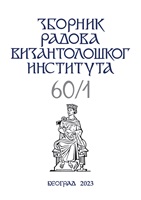DIE ERFORSCHUNG DER KOLLEKTIVE IDENTITÄT IN BYZANZ IM VERGLEICH ZU WESTEUROPA UND DER ISLAMISCHEN WELT: PARALLELEN UND UNTERSCHIEDE IN DER KONSTRUKTION VON „OST“ UND „WEST“
THE EXPLORATION OF COLLECTIVE IDENTITY IN BYZANTIUM COMPARED TO WESTERN EUROPE AND THE ISLAMIC WORLD: PARALLELS AND DIFFERENCES IN THE CONSTRUCTION OF “EAST” AND “WEST”
Author(s): Maria MavroudiSubject(s): Cultural history, Diplomatic history, Political history, Social history, Sociology of Religion, Identity of Collectives
Published by: Vizantološki institut SANU
Keywords: European nationalism; Arabic nationalism; national literature; medieval epic; vernacular;
Summary/Abstract: The paper outlines how modern Western ideas about nationhood (expressed mostly in German in the nineteenth and twentieth centuries) influenced interpretations of the Byzantine and the medieval Arabic past. In principle, the creation of modern secular nation states (an ideal hatched in the eighteenth century and politically implemented in the nineteenth and twentieth) generated scholarly and political debates on whether language or religion ought to be more important to modern communal identities. According to nineteenth-century historiography, the Middle Ages planted the seeds from which modern European nations sprouted. Literary expression in the Western European vernaculars was considered as marking the beginning of „national“ literatures. This partly accounts for the modern neglect of medieval Latin literary culture. This model works for German (a „vernacular“ language distinct from „learned“ Latin) but not for languages like Greek and Arabic, where the „vernacular“ and „learned“ register are conceived as parts of the same linguistic continuum and not as distinct languages. Two nineteenth-century European intellectual phenomena, neoclassicism and medievalism, dictated the artificial split of Byzantine literature into “classicizing” (evaluated as a pale imitation of the far superior ancient Greek literature) and “vernacular” (presumably the beginning of a modern Greek literature). In Arabic, the problem of where to place the beginnings of “national” Arabic literatures (based on the modern Arabic vernaculars) was complicated by the Islamic religious tradition that emphasizes an organic relationship between the Arabic language and the Qur’ān as the direct word of God revealed in the Arabic language through the medium of the Prophet Muḥammad. This leads to two separate historiographical tendencies: one considers that non-Muslims spoke and wrote distinct confessional idiolects (labeled Christian Arabic and Judaeo-Arabic) that were closer to their contemporary colloquial usage than classical (or Qur’ānic) Arabic. The other rejects religious identity as a determinant of language usage. Each position has obvious implications both during the rise of Arab nationalism towards the end of the nineteenth and the beginning of the twentieth century, as well as for nation building in Israel and around the Arab world after WWII. The call for European integration informed scholarship on Byzantium and the Western Middle Ages in the decades following WWII. This scholarship sought to highlight “influence” and later “interaction” between Byzantium and its Western neighbors. The problem that this approach sought to solve was the fact that, in the imagined geography of “East” and “West” as perceived by Western modernity, the exact same geography (Greece and the coasts of the Eastern Mediterranean) were imagined as “Western” in antiquity but as “oriental” during the Byzantine period. From the 1990s onwards (when communist economies from Eastern Europe to China were integrated into a capitalist system after the end of the Cold War), the geographical scope of the quest for cultural interactions across civilizations was enlarged under the rubric of “globalization”. During the same period, scholars felt compelled to revisit the relationship of Byzantium with the Turkish world. The academic impetus was post-colonial theory and the political impetus was the integration of Muslims in Western European countries. Irenic (and therefore post-nationalist) approaches were tried. Such approaches offered revisions to time-honored tropes of Greek and Turkish national historiography and followed a path successfully attempted in order to describe the military confrontations between France and Germany in modern historiography. The difference is that, in the early 2000s (when the youth in France and Germany agreed to prescriptively forget certain aspects of the Franco-German relations in the past) the two countries enjoyed equivalent economic, social, and political conditions. Such conditions are not shared to the same degree between the European and the Turkish and Arab worlds (and even within Europe they seem to be quickly changing). The paper concludes that, when comparing civilizations with one another, one should resist asking which culture did what first, or which proved superior to others according to an ultimately arbitrary set of criteria. The reason is that such questions simplistically position civilizations like horses competing on a race track. One should also resist using civilizations as metaphors through which past wrongs can be redressed at the rhetorical (unfortunately never at the practical) level. Both approaches are relatively straightforward to deploy and have been used by authors comparing civilizations since time immemorial. It is much more complicated, but potentially also more rewarding, to handle individual civilizations as lights that illuminate, with equal brightness, the different contexts within which the same larger experience of being human occurs.
Journal: Зборник радова Византолошког института
- Issue Year: 2023
- Issue No: 60
- Page Range: 247-281
- Page Count: 35
- Language: German

